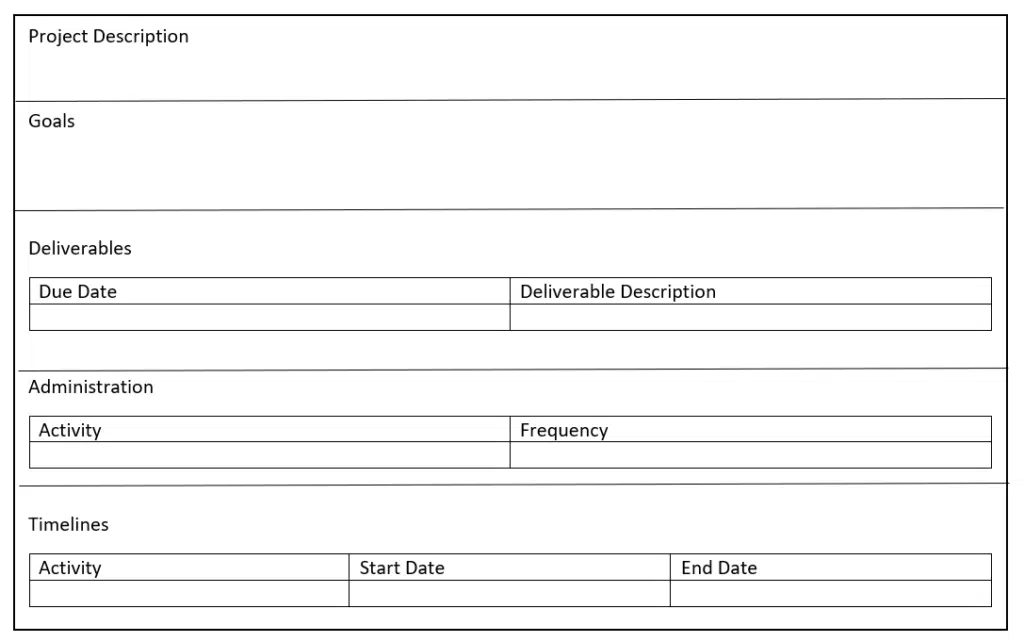The scope of work (SOW) defines the work that must be carried out to complete the project; hence, creating the SOW document is vital for project success.
In today’s article, we will discuss the meaning of the scope of work, its importance, and the step-by-step process of writing SOW. Finally, I will provide a template and an example to solidify your understanding of the concept.
Meaning of the Scope of Work
The scope of work is a detailed document that includes information on how you will complete the project work. It provides specific tasks, responsibilities, and deliverables expected from a project. The scope of work describes what needs to be accomplished, ensuring that all stakeholders clearly understand the project’s objectives and requirements.
Definition: The Scope of Work defines the required work to complete a project. It also includes project milestones, deliverables, reports, etc. A well-defined scope of work helps achieve project objectives with the least hassle.
The key components of the scope of work are as follows:
- Project Definition: It defines the project’s goals and objectives, thus providing a high-level overview of its goals.
- Detailed Tasks: It breaks the project into smaller, more manageable tasks and activities. It specifies what work needs to be done, who will perform it, and when it needs to be completed.
- Deliverables: It lists the deliverables that the project should produce. These are often tangible items or reports that demonstrate the completion of a task or phase.
- Roles and Responsibilities: It assigns responsibilities to individuals or teams, thus clarifying who is responsible for which aspects of the project.
- Acceptance Criteria: It defines the criteria that must be met for the client or project sponsor to accept the project as “complete and successful.”
- Signatures: It is often a formal document that requires signatures from relevant parties (e.g., clients, project managers, and other stakeholders) to indicate agreement and commitment to the outlined scope.
The scope of work is an essential project document that helps prevent scope creep and stakeholder misunderstandings. It provides a foundation for effective project planning, execution, and monitoring, thus ensuring that all stakeholders understand what is expected of them and what is required to achieve project success.
Importance of the Scope of Work
Projects involve multiple stakeholders; therefore, there is a high chance of miscommunication and confusion. Sometimes, a minor error can jeopardize the project’s success. The scope of work helps avoid such situations.
The scope of work ensures all project stakeholders are on the same page with the same project vision.
The scope of work is important for the following reasons:
It Provides Detailed Project Information
The statement of work details the work required to complete the project. Stakeholders can review this document and understand the project and what resources the project will need. It brings all stakeholders on the same page.
It Clarifies Expectations
The statement of work provides details of the project, its objectives, deliverables, and what is included and excluded. All these clarify the expectations of the project.
It Provides Direction to Project Team Members
SOW is the basis of the project management plan. It guides team members toward project success. It is a great communication tool that keeps stakeholders on the same page, helps avoid scope creep, and minimizes conflicts in assigning tasks, roles, and responsibilities.
It Fulfills Legal and Contractual Obligations
The SOW is a critical component in contractual agreements. It helps define all parties’ legal obligations and responsibilities. It protects all parties by ensuring that everyone understands what they will agree to.
It is Used for Budget and Resource Allocation
The SOW is essential for estimating project costs and allocating resources for manpower and materials. This information is crucial for budgeting and resource planning.
How to Write the Scope of Work
You can follow the following steps to write a scope of work for your project:
#1. Define the Project
First, you will introduce the project and define it. Include the name of the project, the organization, and all critical stakeholders. Afterward, you will define the project (e.g., the project objectives and other high-level information).
You can mention the sponsor’s name, key deliverables, what project is intended to achieve, and other high-level assumptions, constraints, risks, etc.
#2. Write the Scope of Work in Detail
Now, you will write in detail what work is required to complete the project. You can brainstorm with your team members, experts, and other stakeholders to get these details.
You provide the details of all project deliverables and the work required to achieve these objectives. Write all the tasks and activities needed to complete the project. The activities and tasks should be in the logical sequence you need to execute and complete the project.
This is a vital part of the scope of work, and further project management documents and planning processes will refer to it during the project life cycle.
#3. Describe the Key Milestones
Every project needs a schedule and timelines, including key milestones and other events. Here, you won’t need to provide any duration or dates for the tasks or activities. These things can be defined during the schedule development process.
#4. Provide the Product Specifications
Every project has an output, which can be a product, service, or result.
You must provide all the possible details of the product specifications and get approval from the project sponsor or client. This is important, and based on this information, the final project deliverable will be validated.
This is again a key part of the scope of work, so write it well. Your project management plan will depend on this information.
Who Should Write the Scope of Work?
The project manager develops the scope of work in collaboration with key stakeholders. The project starts after this document is ready. Any changes to this document require a change request.
If the project is being done through a fixed-price contract, the client will provide a detailed scope of work.
Scope of Work Template
A template of the scope of work is given below:

Example of Scope of Work for a School Building
Project Name: New School Building
Project Location: 123 Main Street, Anytown, CA 91234
Project Number: 123456789
Date: 2023-10-27
Overview
This scope of work (SOW) describes the work to construct a new school building at 123 Main Street, Anytown, CA, 91234. The new school building will be a two-story, 100,000 square foot facility that will house classrooms, offices, a library, a cafeteria, and a gymnasium. The building will be designed and constructed to meet all applicable building codes and standards.
Scope of Work
The scope of work for this project includes the following:
- Site preparation and demolition
- Excavation and foundation
- Concrete and masonry
- Structural steel erection
- Roofing and waterproofing
- Exterior cladding and finishing
- Interior finishing
- Mechanical, electrical, and plumbing
- Fire protection and security systems
- Landscaping and site
Project Schedule
The project is scheduled to begin construction in January 2024 and be completed by December 2024.
Project Budget
The total project budget is20,000,000 USD.
Quality Assurance/Quality Control
The contractor shall implement a quality assurance/quality control (QA/QC) program to ensure all work is performed to the highest standards.
The QA/QC program shall include the following:
- Pre-construction meetings to review the scope of work and identify any potential quality issues
- Onsite inspections by qualified personnel to monitor the work progress and ensure that it meets the required standards
- Testing materials and workmanship to verify compliance with specifications
- Documentation of all QA/QC activities
This is just an example of a high-level scope of work for a school building. The scope of work for your project will vary, depending on the building’s size and complexity, as well as your school district’s specific requirements.
Key Challenges When Writing the Scope of Work
- Scope Creep: If the requirements are unclear, then it can lead to scope creep and other issues, which can affect the project baselines.
- Lack of Skills: If team members lack the necessary project management skills, they may prepare a sound scope of work but miss critical details.
- Lack of Risk Management: If project managers do not follow risk management during their projects, risks can affect the project objectives.
Tips on Writing an Effective Scope of Work
- Before finalizing the SOW document, get key stakeholders’ consensus.
- Be specific with explicit details.
- If required, include visualizations, pictures, files, tables, photos, charts, graphics, videos, links, and examples to increase readability.
- All definitions, business terms, phrases, and acronyms must be explained in the document.
- Project success criteria should be clear, and all stakeholders should agree on them.
- Keep it realistic and consult with subject-matter experts if required.
- Involve the whole team in preparing the SOW document.
Scope of Work Vs Statement of Work
Both scope of work and statement of work are abbreviated as SoW, but they are different.
Scope of work is a subset of a statement of work. A statement of work is a legal document that describes how to achieve the goal, and the scope of work defines the work to complete the project.
For internal projects, the scope of work may only be required, but a statement of work is needed for an external project.
The SOW document can help the project team, and stakeholders agree on requirements and identify potential risks that could impact the project timeline.
The statement of work is built based on the scope of work, and it includes other information (e.g., payment terms and conditions). This document is the first point of reference to avoid any disputes or misunderstandings.
Conclusion
The scope of work is a key project document that describes the work required to complete the project. It helps project managers control scope; without it, scope creep can occur and affect the project’s baseline.

I am Mohammad Fahad Usmani, B.E. PMP, PMI-RMP. I have been blogging on project management topics since 2011. To date, thousands of professionals have passed the PMP exam using my resources.








Wow, what a nice project mgt info!